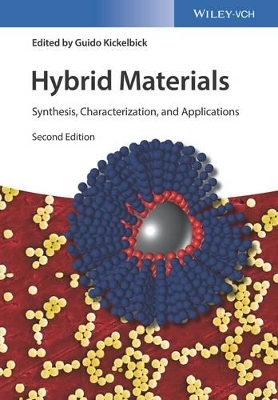
Hybrid Materials – Synthesis, Characterization and Applications 2e
Wiley-VCH Verlag GmbH
978-3-527-33844-3 (ISBN)
Retaining the proven concept, this new edition of the well-received reference has been updated and expanded with 20% additional material to reflect new developments and such hot topics as nanocarbon hybrid materials.
The book is divided into three sections, starting with an introductory chapter that describes basic chemical principles as well as the characterization of hybrid materials. The second part provides an overview of specific types of hybrid materials, including nanocomposites and nanoparticles, natural and artificial hybrid materials, as well as porous hybrid materials. The final section then discusses various applications of hybrid materials, including medical, optical, electronic and electrochemical uses.
With its combination of theory and examples taken from real-life applications, this will appeal to newcomers to the field as well as specialized researchers.
Guido Kickelbick is professor of inorganic chemistry at Saarland University (Germany). He obtained his PhD in the group of Ulrich Schubert at the University of Wurzburg and the Vienna University of Technology (Austria) on sol-gel derived surface-modified metal oxo clusters. He spent one year as a postdoc in the group of Krzysztof Matyjaszewski at the Center for Macromolecular Engineering at the Carnegie Mellon University in Pittsburgh (USA). In 2003 he was appointed as assistant professor at the Vienna University of Technology and in 2009 full professor at the Saarland University (Germany). His research interests are in the field of hybrid materials and nanocomposites as well as surface-functionalized nanoparticles, while focusing on the combination of organic polymers and inorganic components. He has authored more than 200 publications on different aspects of inorganic, polymer and materials chemistry.
INTRODUCTION TO HYBRID MATERIALS
Introduction
Synthetic Strategies towards Hybrid Materials
Crystalline Hybrids
Nanocomposite Components
Structural Engineering
Properties and Applications
Characterization of Materials
Summary
NANOCOMPOSITES OF POLYMERS AND INORGANIC PARTICLES
Introduction
Consequences of Very Small Particle sizes
Historical Reports on Inorganic Nanoparticles and Polymer Nanocomposites
Preparation of Polymer Nanocomposites
Properties and Applications of Polymer Nanocomposites
Summary
HYBRID ORGANIC/INORGANIC PARTICLES
Introduction
Methods for Creating Particles
Hybrid Nanoparticles Obtained Through Self-assembly Techniques
O/I Nanoparticles Obtained by in Situ Polymerization Techniques
Hybrid Particles Obtained by Simultaneously Reacting Organic Monomers and Mineral Precursors
Conclusion
INTERCALATION COMPOUNDS AND CLAY NANOCOMPOSITES
Introduction
Polymer Lamellar Material Nanocomposites
Nanostructures and Characterization
Preparation of Polymer-clay Nanocomposites
Non-Montmorillonite Nanocomposites
Properties of Polymer Nanocomposites
Applications of Nanocomposites
Conclusion and Prospects for the Future
NANOCARBON HYBRID MATERIALS (OR HYBRIDS WITH NANOCARBONS)
General Introduction
Nanocarbon Building Blocks
Synthesis Routes towards Nanocarbon Hybrids
Synergistic Effects
Applications of Nanocarbon Hybrids
Challenges and Outlook
POROUS HYBRID MATERIALS
General Introduction and Historical Development
General Routes towards Hybrid Materials
Classification of Porous Hybrid Materials by the Type of Interaction
Applications and Properties of Porous Hybrid Materials
SOL-GEL PROCESSING OF HYBRID ORGANIC-INORGANIC MATERIALS BASED ON POLYSILSESQUIOXANES
Introduction
Forming Polysilsesquioxanes
Type I Structures: Polyhedral Oligosilsesquioxanes (POSS)
Type II Structures: Amorphous Oligo- and Polysilsesquioxanes
Type III: Bridged Polysilsesquioxanes
Summary
NATURAL AND ARTIFICIAL HYBRID BIOMATERIALS
Introduction
Building Blocks
Biomineralization
Bioinspired Hybrid Materials
Responses
Summary
MEDICAL APPLICATIONS OF HYBRID MATERIALS
Introduction
Bioactive Inorganic-Organic Hybrids
Surface Modifications for Biocompatible Materials
Porous Hybrids for Tissue Engineering Scaffolds and Bioreactors
Chitosan-based Hybrids for Drug Delivery Systems
Summary
HYBRID MATERIALS FOR OPTICAL APPLICATIONS
Introduction
Synthesis Strategy for Optical Applications
Hybrids for Coatings
Hybrids for Light-emitting Sources
Hybrids for Biomedicine
Hybrids for Photochromic and Photovoltaic Devices
Hybrids for Integrated Optics
Summary
ELECTRONIC AND ELECTROCHEMICAL APPLICATIONS OF HYBRID MATERIALS
Introduction
Historical Background
Fundamental Mechanisms of Conductivity in Hybrid Materials
Explanation of the Different Materials
Special Analytical Techniques
Applications
Summary
INORGANIC/ORGANIC HYBRID COATINGS
General Introduction to Commodity Organic Coatings
General Formation of Inorganic/Organic Hybrid Coatings
Alkyds and Other Polyester Coatings
Polyurethane and Polyurea Coatings
Radiation Curable Coatings
Applications
Summary
| Erscheinungsdatum | 09.05.2019 |
|---|---|
| Verlagsort | Weinheim |
| Sprache | englisch |
| Maße | 170 x 244 mm |
| Themenwelt | Technik ► Maschinenbau |
| ISBN-10 | 3-527-33844-6 / 3527338446 |
| ISBN-13 | 978-3-527-33844-3 / 9783527338443 |
| Zustand | Neuware |
| Haben Sie eine Frage zum Produkt? |
aus dem Bereich


